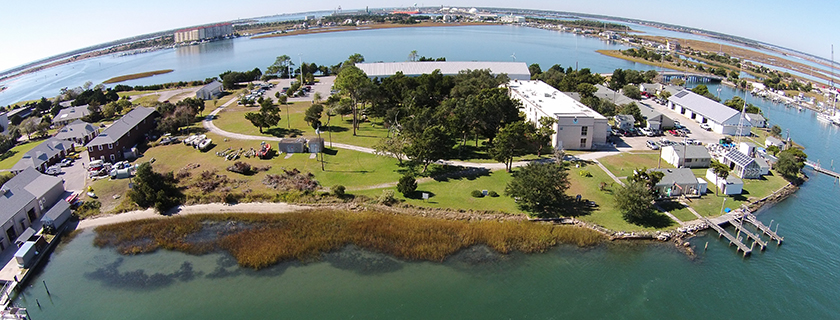Beaufort, NC
NOAA’s Pivers Island Living Shoreline Project
Before & After Hurricane Florence (September 2018): Slide the bar to the left and reveal the change.
After photo above was taken 9 days after Hurricane Florence (September 2018) hit this area of eastern North Carolina as a Category 1 Hurricane with 2-5 foot storm surge and maximum sustained winds of 75 miles per hour from the northeast. The duration of the storm was noteworthy, as tropical storm-force winds persisted over the area for 72 hours. The Beaufort Living Shoreline marsh and oyster reef was intact after the storm, with minimal erosion limited to non-vegetated areas on the landward side of the living shoreline.
Erosion Issue: The sandy beach along NOAA’s Beaufort Lab property on Pivers Island experienced significant erosion in the late 1990s.
Project Technique and Background: In March 2000, NOAA tested the effectiveness of a marsh using cordgrass (Spartina alterniflora) with oyster sill rather than a granite sill or a seawall along an eroded beach. In the summers of 2000, 2006, and 2007, oyster shells (some recovered from bulkheads on site) were placed below the lowest marsh elevation and at the outer edge of mudflats to avoid soft sediments.
The beach was planted with about 500 square meters of Spartina alterniflora in 2000.
Habitat Value(s): The created marsh and oyster reef provide valuable fishery and bird habitat. In addition, the sediment trapped by the marsh improves water quality, and the marsh has effectively sequestered carbon. The carbon sequestration value at a similar site in North Carolina is summarized in a recent scientific article by NOAA scientists, Living Shorelines: Coastal Resilience with a Blue Carbon Benefit. ![]()
Site Resiliency: The site has performed well, and erosion of the lawn has been eliminated. When compared to nearby bulkheads after a hurricane, the living shoreline performed better, as reported in a scientific summary by NOAA scientists titled Impacts of Hurricane Irene on Pivers Island Shorelines. ![]()
The oyster reefs have increased significantly in height and support a living reef. The planted marsh area progressed seaward in response to sediment accretion, and after the oyster clutch was added on the mudflat, the marsh behind it increased.
Partners: NOAA, Duke University, North Carolina Department of Natural Resources
Before & After: Slide the bar to the left and reveal the change.

